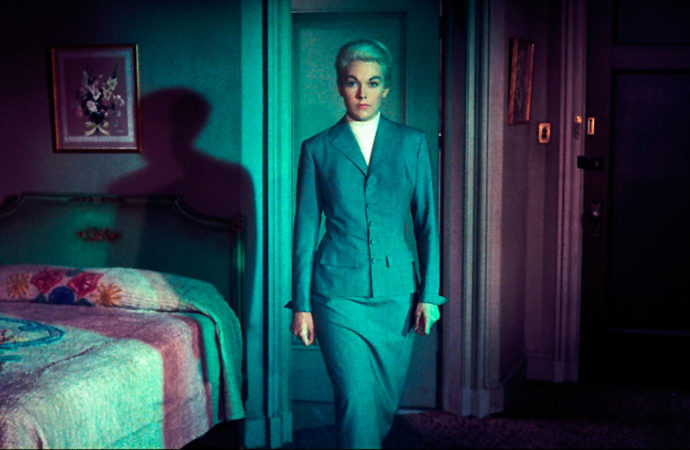In his time, Alfred Hitchcock was considered a commercial director, not an auteur, he gave audiences what they wanted and his films were always among the box-office winners. Perhaps we should bear this in mind to understand how the rigid Hollywood system produced one of the most personal and darkest films in the history of cinema, Vertigo, in 1958.
Neither the greatest exhibitionist nor the most avant-garde of the underground has ever made a film in which you can see so well what goes on inside his mind as Hitchcock did here, in what can be considered the great culmination of the concept of “director/author”, of which the guys at Cahiers du cinéma who were about to create the Nouvelle vague talked so much.
That is why I firmly believe that Vertigo is his best film, although it is certainly not his most representative, it is his most personal. Here we enter the darkest corners of this director who maintained a sexless marriage, but found in the camera his most faithful ally to look into places, situations and people that would be forbidden in real life for someone who defined himself as an unusually unattractive young man.
Vertigo is a journey into the darkest corners of the director’s mind, into the obsessive control of his actresses, of his most primitive impulses.
Vertigo is the story of a man totally infatuated with a missing woman, an obsession that will lead him to model another woman with similar features, in her image and likeness. The funny thing is that Hitch had lost his favourite actress, Grace Kelly, for whom he was totally fascinated, and he needed to find in another woman everything that attracted him to her. It is logical that he found the script of this film fascinating, as this story was about him and his more murky passions. Just look at the way he introduces us to the character of Kim Novak (Kelly’s replacement), it is true poetry, not a woman, but a fantasy.
But it’s like that from the beginning, the credits are totally representative, an uncomfortable and distressing music, a female face in black and white and close-up, we only see the nose and lips, the close-up closes on them, the name of James Stewart appears, the shot goes up to the eyes that look at the camera, then to one side and to the other, and they stare at us again, the name Kim Novak appears, the shot closes again on the right eye, then it appears to us that we are in an Alfred Hitchcock film, then the shot closes even more on the eye and the black and white turns into a passionate red and from the eye pupil the title of the film, Vertigo, appears until it is framed inside the eye. For the director, vertigo was not caused by heights, but by blondes…
This is a film that is the fantasy of a voyeur and a fetishist, someone who was obsessed with his actresses in a strange and morbid way. It is a journey into the darkest corners of the director’s mind, into the obsessive control of his actresses, of his most primitive impulses. It is a contemplative film, in which for many minutes nothing is said, and in which Hitchcock decides to break with suspense (something rare for him) to make it clear from the start that the two characters played by Novak are the same person. Here he is not interested in suspense, but in psychology.
The fact is that Vertigo is Hitchcock’s first film without his ideal muse, the icy blonde who hid a fire inside her. Hitchcock had always disliked Latin sex symbols, mainly Italian, they were too voluptuous, their shapes left little to the imagination. This ugly and obese voyeur was always a great fan of imagination, for him eroticism was to be found in sophistication and in what was not seen, what was imagined.
That is why I always considered that the key scene in this film was the one in which Kim Novak’s character performs what we could consider a backward striptease, that is, James Stewart’s character is modeling her to look like the woman who committed suicide in front of him, he has bought her the same clothes, he has put the same make-up on her, he has dyed her hair, but her hairstyle is not exactly the same. They are in his room, and he still doesn’t see her exactly as in his fantasy, and that’s what it really is, a fantasy, since the woman who committed suicide is the same as the one in front of him, only that before she was playing a creation made for him to fall in love with her and that’s why he resists the change, he wants him to love her as she really is, not as the fantasy he dreamt of.
In the end, she agrees and goes into the bathroom, the lighting of the scene is slightly unreal, with a green hue coming from a neon light by the window. He is nervous, excited and can’t stand the wait, then the bathroom lock clicks and the door opens, Stewart turns around with his eyes in ecstasy, she is lit up like a ghost, she is an apparition, she has finally done her hair the way he wanted, she walks towards him and they kiss passionately.
The director explained the scene perfectly to François Truffaut in his famous book of interviews: Stewart’s character, Scottie, wants to have sex with this dead person, in other words, we are talking about necrophilia. To do so, he has to achieve the total transformation of Judy (Kim Novak’s character), in the dream fantasy (who had also played Judy herself), but she resists, because she wants him to love her, not her character, but that doesn’t satisfy Scotty.
Now let Hitchcock explain: He’s not completely satisfied because she hasn’t combed her hair into a bun. What does this mean? It means that she is almost naked in front of him, but still refuses to take off her panties. And then, when she comes out of the bathroom, it’s the full striptease. Scotty has broken – one might say denigrated – poor Judy and is fulfilling her erotic fantasies.
It is the fantasy of a voyeur and a fetishist, someone who obsessed over his actresses in a strange and morbid way.
The funny thing is that if we take all this into account and add to it Hitchcock’s obsession with Kelly, and the profound rejection he felt for the actress’s cinematic abandonment, we have a film that is an amateur psychologist’s paradise. One of the greatest directors of all time, putting his obsessions and paraphilias into a film and transforming one actress into another, in a role where she has to play the fantasy of a man, then fall in love with that man and then watch as that man rejects her to transform her into that fantasy, all with the perverse pleasure of a voyeur watching it all from that sacred tool of voyeurism that is the camera. By the way, Hitchcock never again worked with Novak after Vertigo.
It was only natural that a couple of years later another iconic English director, Michael Powell, a contemporary of Hitchcock’s, would release his most personal film, Peeping Tom, in which a psychopath kills women while filming them with a camera. The same year, by the way, Hitchcock would shoot Psycho, it’s a good thing that certain paraphilias and obsessions can be resolved in art better than in life…









No one has posted any comments yet. Be the first person!